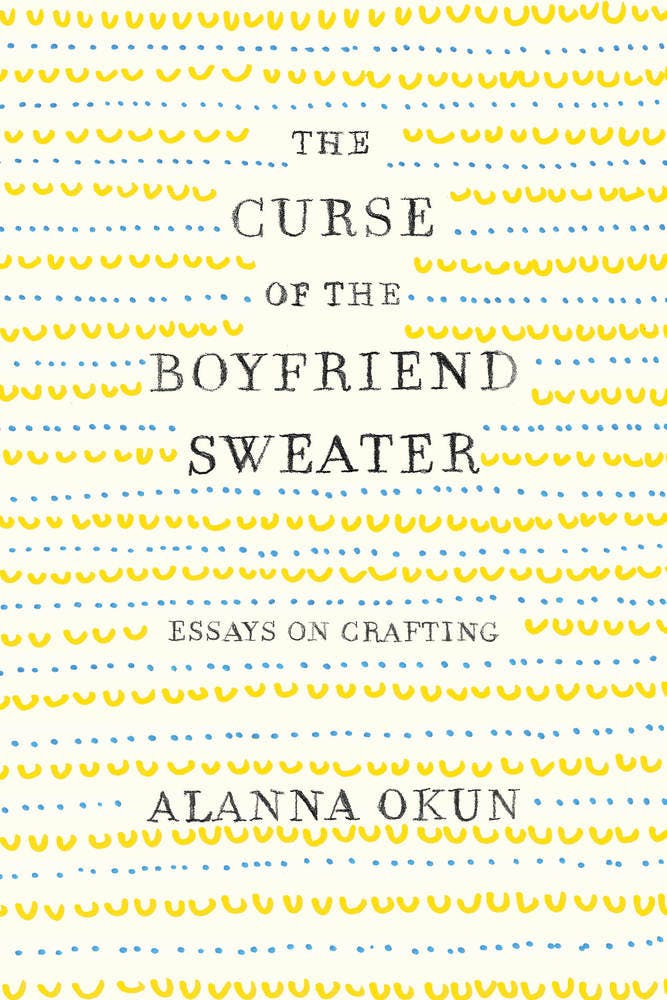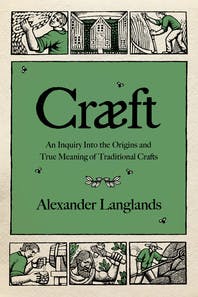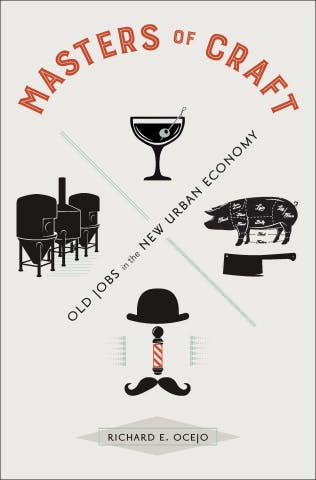What
is knitting, really? Just string in a particular shape. A handmade sweater is a bit like a life: some raw material,
threaded over time in certain combinations that together constitute a
distinct entity. Time is the property that distinguishes a crafted sweater from one summoned in a flash by a
machine. A human being has dedicated moments of their life to produce this
object. And if we raise our gaze from the knitting needles to the person holding them,
we meet another mystery. Who is the craftsperson?
Three recent books answer that question in three different ways. The Curse of the Boyfriend Sweater is a new book of essays by Alanna Okun, an editor at clothing site Racked, that recalls her life through the medium of yarn. Craeft: An Inquiry Into the Origins and True Meaning of Traditional Crafts is also a memoir-type analysis of artisanal trades, written by Alexander Langlands, an archaeologist and historian who has made various TV shows for the BBC about farming using traditional techniques. Finally, Richard E. Ocejo’s book Masters of Craft: Old Jobs in the New Urban Economy looks at the rise of occupations like distilling, butchering, and barbering.

The titular curse of Okun’s book is an idea within the crafting community that if you begin to knit a sweater for your partner, the relationship will end before the sweater is done. (She calls it “the opposite of Engagement Chicken.”) In describing her journey to create a garment for a loved one, Okun blends emotional insight with the literal material of knitting. “When I’m not with somebody I can get destabilized, a little manic,” she writes, “straining against the edges of my life like I’m trying to squeeze my head through a neck hole that’s too small.”
Okun’s tone is bright and funny, even and perhaps especially when she is edging into deep pain with her needles. Her essays have names like “Frogging, Or, How to Start Over”; “Things I Do Wrong, At Least as Far as Crafting Is Concerned”; “Knitting Myself Back Together.” It is reminiscent of Nora Ephron—charming and lighthearted, but bright with vulnerability. The tiny baby sweater Okun knits helps her to conceive of new life after the death of two friends. “Making anything feels like seizing control,” she observes.
Disclaimer: Okun is a friend. I divulge this for ethical reasons, but also because I have seen her knit a sock in a bar booth while talking animatedly, not even looking at her work. The concerns of her book are perhaps modest. They are about being a post-college white woman in the process of creating a self: finding a best friend, breaking up with a partner, finding an apartment, falling in love. But even though a sock is a small thing—held at table level, growing slowly, the needles clicking—Okun achieves the singular feat of locating herself inside the process of sock-creation and doing it with great humor.
If Okun’s book connects to a feminine tradition of writing comically about life’s trials, Langlands’s book Craeft taps into a masculine one. He also writes in a jocular tone, but with the English timbre of a man who says “chap” a lot and emphasizes how well he gets along with workers on a construction site. In the preface, Langlands tells the story of how his strimmer—a motored tool to trim grass—broke. In need of a substitute, Langlands pulls an old scythe out of the cupboard. He has a vision of himself “slashing through acres of luscious meadow grass between manly swigs from a cider flagon.”
At first he does a terrible job. A passing gamekeeper laughs at him through the window of his Land Rover. The gamekeeper sharpens the blade with a whetstone and shows him how it is done. Soon enough Langlands has got the hang of it, slicing with skill while listening to the birds that the strimmer’s racket had drowned out.
The depths of Langlands’s crafting ability is beyond doubt. He describes how to weave a skep, an old-fashioned beehive, from bramble and straw. He teaches the reader how to create hay from grass, with all the complicated weather forecasting that involves. But there is an explicit and an implicit politics to this reclamation.
Langlands’s nominal intention is to assert the values people have lost through mechanization. Electronic machines save labor, yes. “But as a wider consequence, fabrication, construction, energy, waste, and by-product are largely monetary abstractions to a society of non-makers,” he writes. The distance placed between objects and our hands is a problem. “It occurred to me that if we spent more time individually converting raw materials into useful objects, we might be better placed to contextualize the challenges that face a society addicted to excessive and conspicuous consumption. Perhaps more importantly, we might be happier.”

The question of happiness is an interesting one. Okun’s book suggests that a connection with the material objects we live with (and wear) can offer a way out of unhappiness. People these days who make things like socks—or ceramics, or furniture—often do so because it makes them feel good. Creating “content” online is a sadly abstract practice, and most of us work at keyboards rather than kilns. Manufacture with the hands has an undoubtedly therapeutic quality.
But Langlands’s interest in craft has a different connotation. He acknowledges the reactionary component of the Arts and Crafts Movement at the turn of the 20th century, its romanticism. But he seems less aware that his own fantasy is about returning to an England before the Industrial Revolution. The flavor of his artisanal practice is jolly, macho, and altogether reminiscent of the masculine scenery of a Thomas Hardy novel. Yes, the Industrial Revolution gave rise to working conditions that exploited the poorest members of society, and continues to exploit those people with the uneven development that machinery has wrought. But there is no pure English past available for return. Trying to create one is the prerogative of a person hampered by an extremely partial vision of a rural sublime. That vision is not inclusive of the people—namely women and the rural poor—for whom manufacturing used to be physical servitude. It’s also oblivious to the hundreds of migrant laborers who are the remaining workforce using their hands in British agriculture today.
I’m scolding Langlands here, perhaps unfairly. His description of all the various sticks in his house—for walking, for cricket, for fruit-picking—is charming in the way that it is always charming to hear somebody enthuse about objects they love with all their heart. The archeological context he brings to his analysis of traditional tools is fascinating. But the problem lies in Langlands’s omission of the marketplace. Perhaps we would be happier if we could choose to weave baskets all day. But this is not the structure of the world we live in, and it ignores the reality of manufacturing.
Masters of Craft takes the opposite approach to contemporary artisanship. Richard E. Ocejo is an associate professor of sociology at John Jay College in New York. His interest in jobs categorized under “craft” began with the personal. Growing up in Brooklyn, his Spanish grandfather was a barber, an occupation that felt “honest” to the family and that his father inherited.
Ocejo grew up to be a “knowledge worker,” with manual labor never on the cards for him. But as a researcher he was drawn to the cocktail culture of New York, at bars like Death & Co. in the East Village. He began studying the distilling industry, then extended his study to men’s barbers and whole-animal butchers as the questions guiding his inquiry broadened: “Why have some traditionally low-status service, manual labor, retail, and light manufacturing jobs become ‘cool?’”

Masculinity, labor markets, social mobility, and gentrification have all played a part in the revival of craft professions. But “cool” is the hardest-to-grasp concept in the book, and its meaning becomes a central question. It’s an idea strongly related to consumerism, linking these old-fashioned jobs to “nightlife, alcohol, style, and food.” The argument at the core of Masters of Craft is this: “the upscale, new elite versions of these classic, common occupations have become cultural tastemakers.” To make tastes is to generate them, and Ocejo specifies that those new tastes are “omnivorous.” They proliferate out into the “gentrifying city and legitimate employment options for young, well-educated, and/or culturally savvy workers,” those who are entering the labor market “at a time in urban history when the meanings behind ‘good’ tastes and ‘good’ jobs are changing.”
Ocejo approaches his subject with the consistent, detail-oriented strategies of the sociologist. The book is full of interviews and anecdotes, like a carefully transcribed conversation with a barber. Ocejo also uses a strong “I,” however, doing the extra duty of harnessing his research to a subjectivity that is inevitably flavoring his conclusions. It’s an extremely timely survey of a labor field that has been slightly beyond the powers of description for a lot of critics and social commentators. Cool is so difficult to quantify. But incomes are quantifiable, as is data about who has what job, and gentrification studies are one the rise. Masters of Craft is a landmark.
This trio of books work together so well that they ought to be offered as some kind of bookstore deal. They combine personal voice, the agricultural context, and sociological labor analysis to attack a lot of ideas that are percolating in the culture. But there’s a fourth piece of reading that should perhaps be printed out and included with the customer’s receipt as they leave the store: Lauren Michelle Jackson’s Eater essay, “The White Lies of Craft Culture: How the world of small batch, single origin, and totally artisanal erases the people of color who made it possible.” Ocejo’s book is conscious of the racial dynamics of the crafting industry, the whiteness that operates as a crucial element of gentrifying small business networks. But Langlands’s book reinforce a politics that Jackson rightly diagnoses as afflicted by a white blind spot:
Craft culture tells mostly white stories for mostly white consumers, and they nearly always sound the same: It begins somewhere remote-sounding like the mountains of Cottonwood, Idaho, or someplace quirky like a basement in Fort Collins, Colorado, or a loft in Brooklyn, where a (white) artisan, who has a vision of back in the day, when the food was real and the labor that produced it neither alienated nor obscured — and discovers a long-forgotten technique, plucked from an ur-knowledge as old as thought and a truth as pure as the soul.
That idea of historical purity lies under every conversation about craft that seeks to tie it to some mythical time in the past, before all the machines and complications and difficulty of the contemporary world were invented. That is, as Jackson writes, a faulty vision. She cites the “hidden history” behind distilling—“that six slaves were critical to the operation of George Washington’s distillery, and that the eponymous Jack Daniel learned to make whiskey from an enslaved black man named Nathan ‘Nearest’ Green.” Craft barbecue and coffee-making are also subject to this historical amnesia, erasing the foundational contributions of people of color and their ongoing, under-remunerated labor. This amnesia destines the craft industry to “succumb to the same cycle of alienation as the mass-produced culture it once stood against.”
Langlands’s book is mostly about the U.K., so it is not subject to the precise critiques that Jackson presents. But if anything, the vast history of British colonialism make his book’s problems even bigger. Okun’s book escapes the traps of crafting’s lilywhite cultural apparatus, by focusing with rigor and insight on the single self. She makes no claims that she cannot support with her own experience, and does not extend them into grand narratives about culture. Ocejo’s book, meanwhile, is a critique of all these elements, but with a strong focus on the American urban context.
Intangible concepts like happiness, grief, cool, and loss run through every one of these three books, and Jackson’s essay. That’s part of the paradox of the subject. How can one write about the very thing that the writer is promoting as the opposite of writing? Knitting a sock or whittling a walking stick or fashioning a vase from clay are all practices that derive their therapeutic quality, I think, from their nonverbal modality. And when one produces an object—especially if it destined for sale or practical use in a business—that act of production exists within systems through which capital (both financial and cultural) flows. It is so hard to see oneself as part of a system, while we are inside the system. But as a group of works, these books function well as a collaborative attempt to contextualize, value, and promote the act of making something with one’s hands. It’s difficult to put that into words, but maybe not quite as hard as making a sock.
